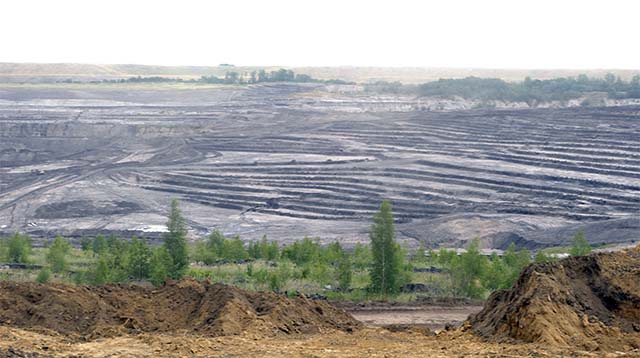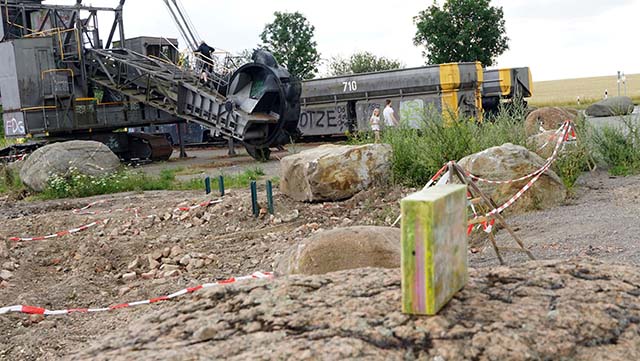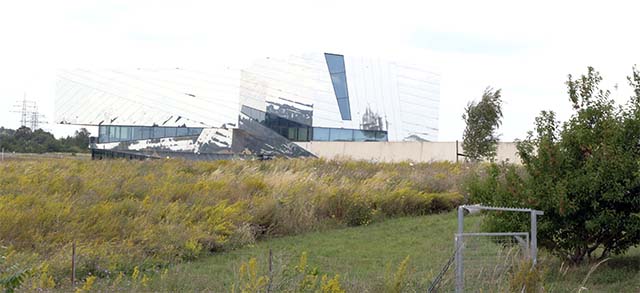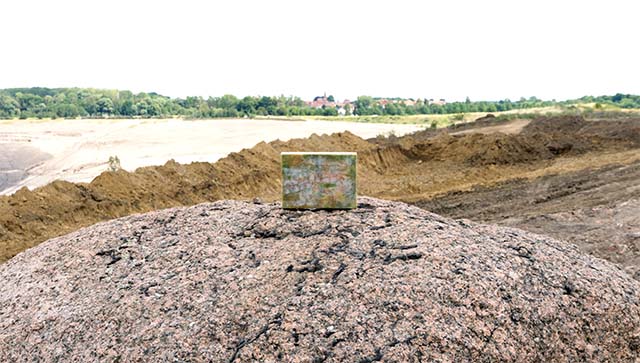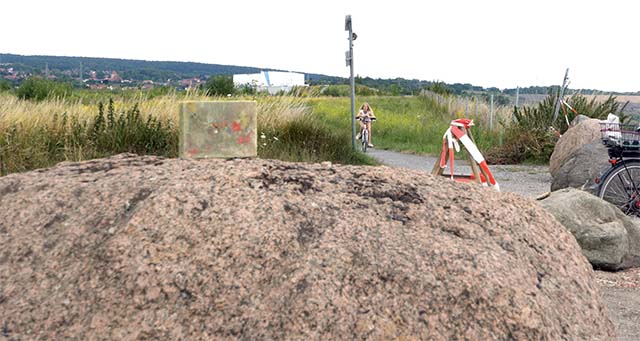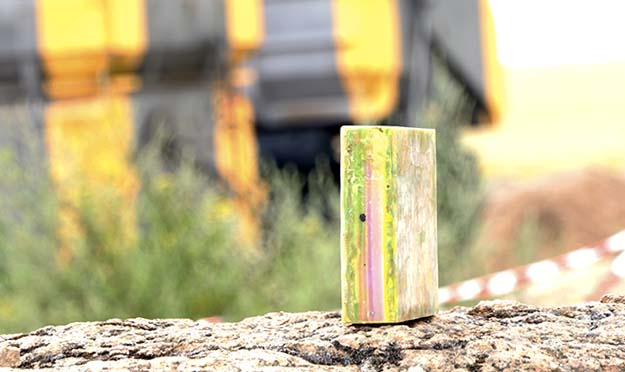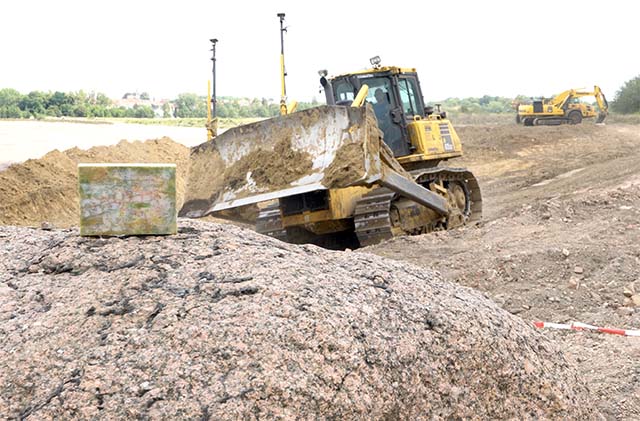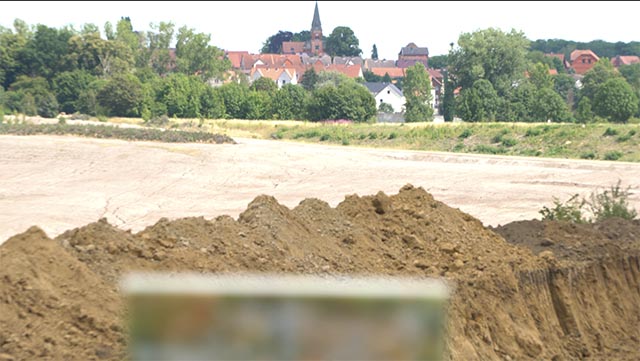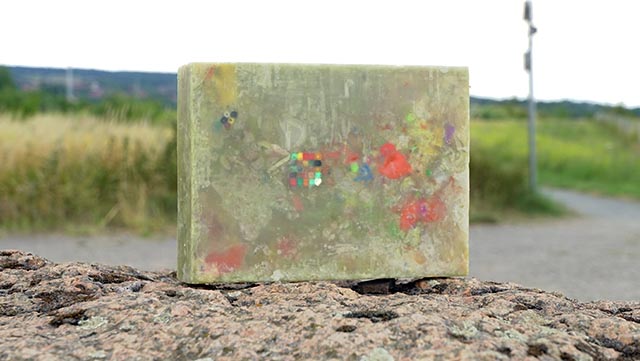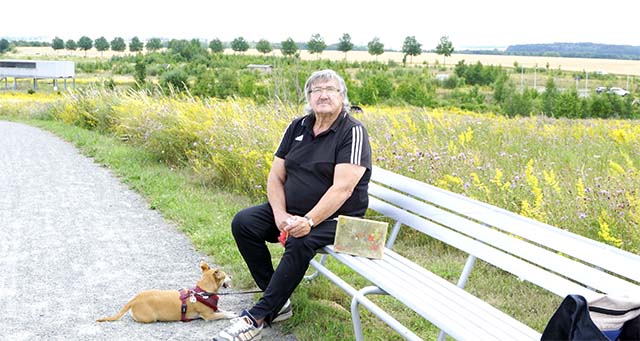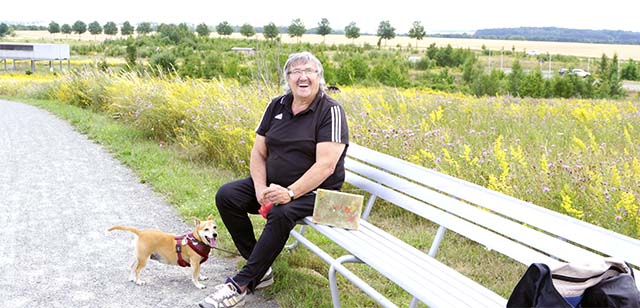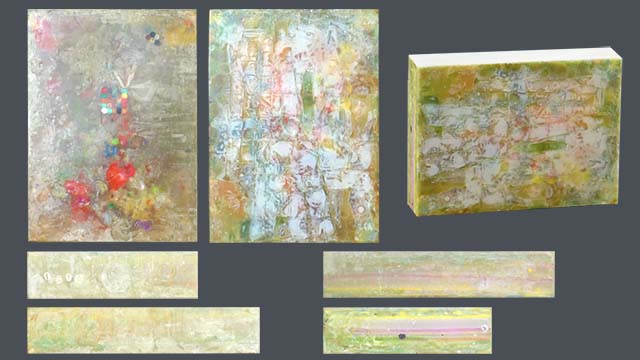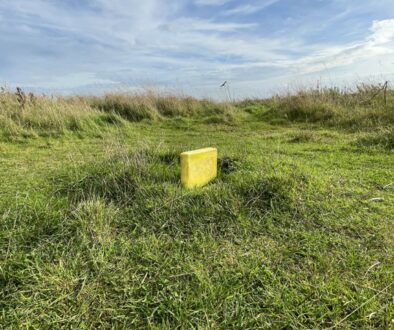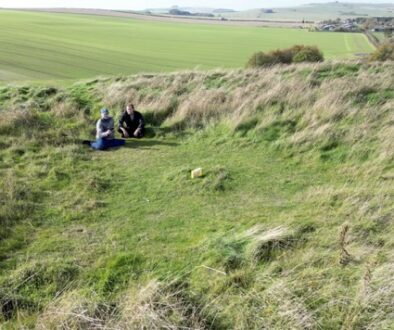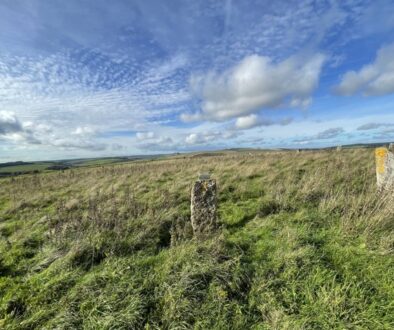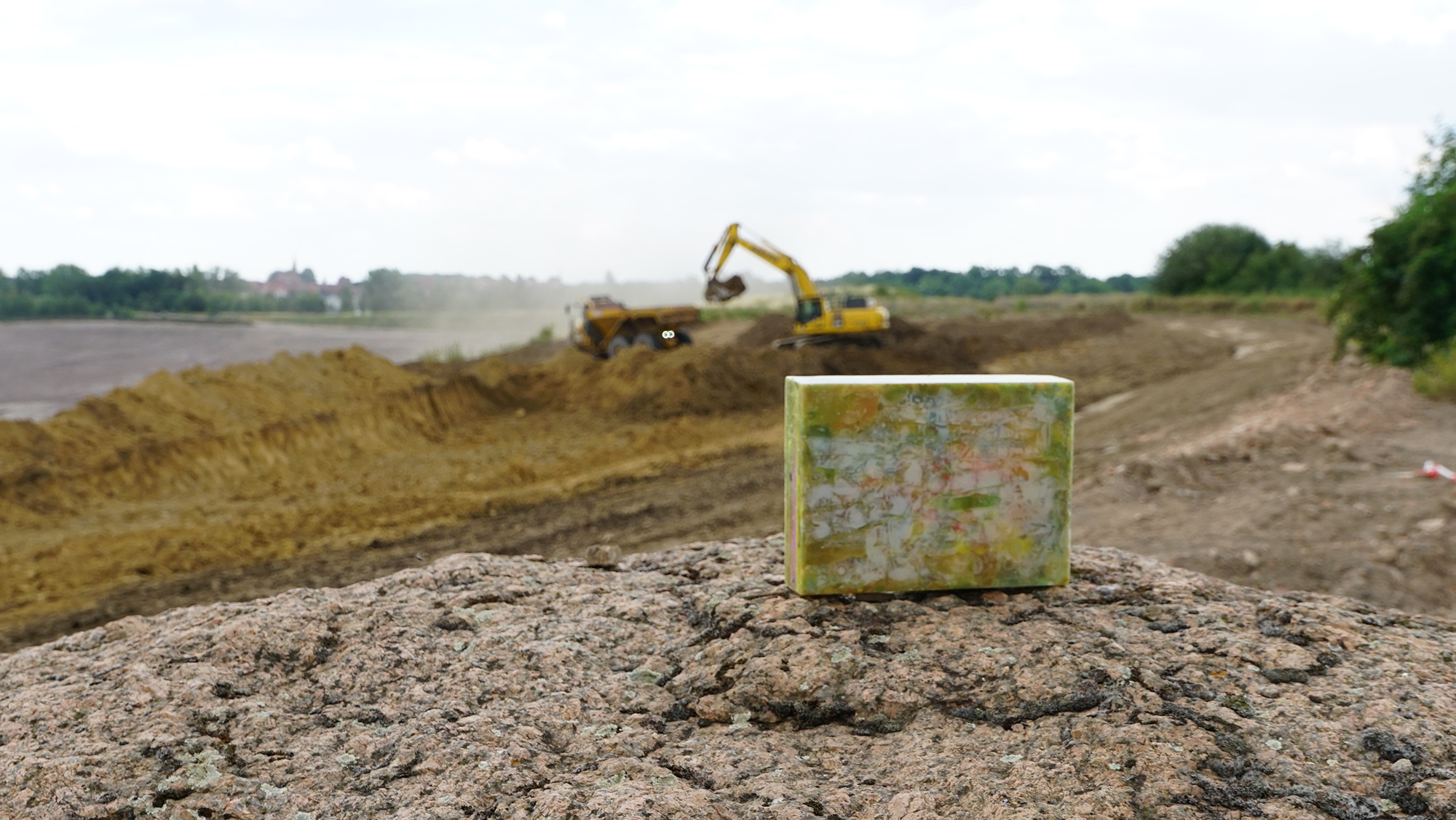
The place of “1C1B-FINDLING” tells human stories as old as 300,000 years.
Schöningen is a town in the district of Helmstedt on the Elm Mountain range. It is located about eleven kilometres southwest of the Lower Saxony district town of Helmstedt on the border to Saxony-Anhalt.
History
Early humans lived in the area around Schöningen as early as the Palaeolithic Age. In 1994, excavations at the former Schöningen open cast mine revealed the “Schöningen spears”, which are over 300,000 years old. The throwing implements are the oldest completely preserved hunting weapons and represent important evidence of active hunting by Homo heidelbergensis. The excavations in the Schöningen open pit mine that have continued since then have led to other important discoveries, such as the discovery of the throwing stick from Schöningen as the oldest specimen worldwide, the discovery of the forest elephant from Schöningen and the discovery of several sabre-toothed cats.
There is evidence of continuous settlement in the town of Schöningen, which was particularly important because of its salt deposits, from around the time of Christ’s birth. It was a royal court in Carolingian times, was first mentioned in a document in 747 together with Ohrum as “Scahaningi” and is thus the oldest town in the former Duchy of Brunswick. The Schöningen salt works were already located here at that time. Both Pippin the Younger and Charlemagne passed through Schöningen on their military campaigns. King Otto III also held court camps here several times in 994 and 995, and his chancellor Archbishop Willigis of Mainz is said to have been born in Schöningen. Several noble families had their seat at the edge of the Elm, and in the 13th century the Order of Teutonic Knights was given Elmsburg Castle, which lies in the Elm near Schöningen. The noble lords of Warberg were impartial to the empire and subject only to the king. When the dynasty became impoverished in feuds, it gave its possessions to the Guelphs as a fief. Around 1347, the Guelphs had already built Schöningen Castle, a strong fortification to protect their eastern border.
From 1949 to 1989 Schöningen was located in the border zone, directly on the inner-German border. In 1976, the pedestrian zone was opened. In 1989, Der Spiegel reported on an NSA listening station. On 19 November 1989, in the course of the reunification, the border was opened and the road to the neighbouring village of Hötensleben with the bridge over the Schöninger Aue was cleared.
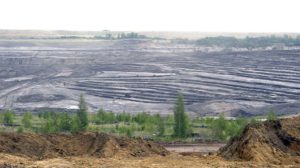
The archaeological excavation sites in the Schöningen opencast mine include about 50 sites from prehistoric and early historic periods that were archaeologically investigated during the development of the Schöningen opencast mine from 1983 onwards. The excavations are among the largest archaeological measures in Lower Saxony, which continue in a small area to this day. From 1994 onwards, they led to the discovery of the Schöningen spears and other significant finds from the Palaeolithic period.
Origins
From 1979 onwards, the Schöningen open-cast mine in the Helmstedt lignite mining area was developed, first by a north field and later by a south field, covering a total area of about six km². Since a large number of archaeological sites were to be expected on the emerging opencast area, the archaeologist Hartmut Thieme from the Institute for the Preservation of Monuments in Hanover initiated the long-term project Archaeological Focus Investigations in the Helmstedt Lignite Mining Area (ASHB) in 1983. It was made possible by the promise of the Braunschweig coal mines to support the rescue excavations in the long term. The aim of the project was to document, in an exemplary manner, the prehistoric and early historical legacies of man over a large area without any gaps. In addition, the project served to reconstruct the former environmental conditions through geological and palaeobotanical investigations.
Excavation procedure
Archaeological excavation in the Schöningen open-cast mine
Before the excavations were carried out by the bucket-wheel excavator, archaeologists systematically examined the planned excavation areas by making approximately two-metre-wide search cuts in the ground at 100-metre intervals. When archaeological features were encountered, the search cuts were made more closely meshed or extended to excavation areas where rescue excavations took place. About 30 years after the start of the project, areas of 400,000 m² had been excavated in 2012. The search in the near-surface Holocene deposits with Neolithic, Bronze Age and Iron Age sites was the main focus of the archaeological investigations until 1991.
With the development of the southern open-cast field by the mining company in 1992, the archaeological measures were shifted into the depths. This was made possible by excavators cutting into the earth, exposing deposits from the Ice Age. The archaeologists searched the Pleistocene layers for human remains from the Palaeolithic period.
Later, opencast lignite mining no longer touched any archaeological sites. This changed the character of the excavations from rescue excavations under time pressure to funded research excavations. In 2016, the open-cast mining was stopped. Archaeological investigations are still continuing in the vicinity of the Schöningen spear site.
Geology of the Pleistocene
Geological sequence
Pleistocene strata were first documented during the long-term project in 1991, and archaeologically relevant finds were discovered shortly afterwards.[2][3] The area around Schöningen belongs to the Helmstedt Lignite Basin, which forms the northwestern extension of the 70 km long Helmstedt-Staßfurt Lignite Basin. This is divided in two by a Zechstein saddle. The opencast mine is located in the southwestern part of the northwest-southeast oriented rim depression of the narrow salt dome. It is filled with Paleogene deposits overlain by Quaternary cap layers up to 30 m thick. The lower depositional units of the Paleogene, the so-called Schöningen Formation is considered an important climatic archive from the time of the transition from the Paleocene to the Eocene.
The base of the Quaternary sequence is formed by the ground moraine and meltwater sands of the Elster glaciation. At least three gullies (Schöningen I, II, III) are deepened into this glacial sequence, which run parallel along the Zechstein saddle and partly overlap each other. They are filled with limnic-telmatic sediments deposited under warm-age conditions. The closer the gullies are to the salt dome, the younger they are. These three gullies are overlain by the glacial series of the older Saale glaciation (Drenthe), which also passes over the remains of the Elster glaciation. A gully (Schöningen IV) is also deepened into the Saale period ground moraine, which contains a duplicated soil complex. The Saale ground moraine is overlain by a thick loess, which contains another gully (Schöningen V). A final gully (Schöningen VI) is deepened into the loess.
The six gullies were originally interpreted by Dietrich Mania as relics of a separate climatic cycle in each case. From a geological point of view, the Schöningen I to III gullies belong to the period between the Elster and Saale glaciations. In Mania’s view, each gully represents a warm period, which means that Schöningen I comprises the Holstein Warm Period, Schöningen II the Reinsdorf Warm Period and Schöningen III the Dömnitz Warm Period (Schöningen Warm Period). The fourth gully would then be classified in a warm period after the Drenthe Ice Advance (so-called “Intrasaale Warm Period”), the fifth gully comprises the Eemian Warm Period and the sixth the early Holocene. Supporting this view, the Schöningen gully sequence should be found in the cycles of the Bilzingsleben travertine sequences in Thuringia.
Deviating from the original interpretation of the older three gullies of Schöningen as each being independent remnants of warm-climate climatic cycles, a more recent version views them as a single marginal depression. This has its origins as a subglacial tunnel valley that was only incompletely filled in during the outgoing Elster glaciation and existed as a lake during the subsequent warm period. This lake was then gradually filled in from the west with sediments from the Elm. The period of formation of the individual gullies would thus be limited to one, at most two warm periods. The absolute age dating obtained so far confirms this view. Accordingly, the Reinsdorf Warm Period would be identical to the Holstein Warm Period.
Landscape reconstruction
The oldest three gullies yielded a rich faunal and floral community with both macroscopic and microscopic remains. According to pollen analyses from the Schöningen II gully, the vegetation succession deviates characteristically from the Holstein Warm Period and was therefore assigned to the Reinsdorf Warm Period. Macroscopic plant remains in the form of fruits, seeds and wood show the Tatar steppe maple as a typical element indicating a pontic-subcontinental climate. It was associated with the field maple, the littleleaf linden, the common ash, the blackthorn, the red dogwood and others. They all point to an open landscape with individual forest islands, a forest steppe, which is typical of south-eastern Europe today. This, however, distinguishes the flora from that of the Bilzingsleben site, which is considered to be contemporary, where a mixed boxwood-oak forest predominated.
The south-eastern European character of the flora of the Schöningen II gully is reflected in the mollusc fauna, which is dominated by the snail Helicigona banatica. In the mollusc community, which comprises more than 80 species, numerous southern and south-eastern European representatives occur alongside the generally present-day central European forms such as the garden snail, the Hain’s ribbon snail and the Roman snail, including the pagoda snail, the narrow-billed crystal snail, the whorl snail and the light cylindrical diaper snail. They speak for a Mediterranean-influenced landscape of forests and open landscapes. The High Warm Period molluscan fauna is replaced in the hanging sediment layers of the Schöningen II gully by a loess steppe and swamp raft fauna dominated by Pupilla.
The vertebrates are indicated by fish, reptiles, birds and mammals. The large mammal fauna can be addressed as Palaeoloxodon antiqiuus fauna, typical of the warm periods of Central Europe. In addition to its characteristic form, the European forest elephant, steppe and forest rhinoceros, the Mosbach horse, the European wild ass, aurochs, steppe bison as well as red deer and roe deer are represented, as well as numerous predators. Among the small mammals, the old beaver (Trogontherium) can be highlighted, indicating a pre-Saale age position. A similar assumption is made by the water voles, whose tooth enamel thickness (the so-called enamel band differentiation quotient) indicates a comparable age to Bilzingsleben. The horse remains, on the other hand, are different, as they are considered by Rudolf Musil to be more modern than the corresponding finds from Bilzingsleben. An exotic species among the small mammal fauna is the desman, whose closest relative, the Russian desman, is widespread in Siberia.
Among the other vertebrates, the European pond turtle stands out as a warm-climate indicator, which occurs with individual shell fragments in the climatic optimum and is now bound to the 20 °C isotherm in Central Europe so that its clutches hatch. In addition, the adder, grass snake and wood lizard or sand lizard are documented among the reptiles, amphibians occur with frogs (common toad, spadefoot toad, grass frog) and caudates (pond newt), while the nearby lake is indicated by roach, rudd and pike. Burbot and bullhead indicate nearby flowing waters. However, as the lake silts up, the fish fauna changes markedly.
Pleistocene sites
Schöningen 13 I
The Schöningen 13 I site forms the archaeologically oldest in the entire Schöningen site area. It is located in Gully I, which is filled with silt, peat and basin clays. The first finds came to light at the base of this sedimentary sequence in 1994. The area was then investigated over an area of about 120 m². Around 550 objects were found, including broken animal bones, most of which could be attributed to hoofed animals. Red deer, giant deer and aurochs could be determined with certainty. There are also remains of steppe mammoths, rhinoceroses of the genus Stephanorhinus and horses, possibly Equus mosbachensis (Mosbach horse). The find horizon also contained flint artefacts as evidence of the presence of early humans. In addition to numerous flakes as waste products of core and raw nodule working, these also include individual implements. These mainly show simple edge working in the form of coves and denticles, which is often associated with the processing of organic raw materials. In addition, pieces of rubble and around 50 fire-cracked stones are recorded, indicating possible fire use. Thermoluminescence dating on the burnt silices gave a provisional age of around 400,000 years, arguing for a position within MIS 11. Later analysis revised this to around 321,000 years, indicating a younger Warm Period cycle (MIS 9). Further excavation work took place in 1999 and 2014, involving smaller areas. Thus, around 90 finds were found on 30 m². About 1.5 m above this site, a tread horizon with tread seals of elephants, rhinoceroses and other large mammals was discovered.
Schöningen 12
Schöningen 12, located at the northern edge of the South opencast field, belongs to the Schöningen II channel. The channel is filled with sediment series representing five sedimentation sequences. The first sedimentation sequence consists of basin silts, various silts (silt, clay and lime silts), loose travertines and peat (fen and forest peat) and indicates the climatic optimum of a warm period about 300,000 years ago. The upper four sedimentation sequences already represent the cool-climate late interglacial. They are composed of caracal silt and fen peat. In the uppermost sedimentation sequence, frost structures already appear. Several find horizons were encountered in this gully. The Schöningen 12 site is located in the first sedimentation sequence. It was discovered in 1992 and subsequently excavated over an area of about 150 m². The find layer 2, which is about 2 to 3 m higher, covers an area of 30 m². Both find horizons were formerly located directly on the lakeshore. They contained flint material and bones as well as wooden artefacts. The large mammal bones in particular are often smashed and show cut marks, so that they can be interpreted as human food remains. The flint artefacts include flakes as well as implements, cores and debris. The tees were generally obtained by the hard chipping technique. The implements have predominantly bent and toothed edges. Sometimes two working edges occur, which are right-angled or acute-angled, but bifacial techniques, i.e. pieces worked over two surfaces, are rare. Find layer 1 also yielded three wooden shafts, which are between 17 and 32 cm long and each have an incised notch at one end. A fourth object is only 11 cm long, but has a notch at each end. All pieces were made from silver fir. Presumably, the timbers were used as clamp shafts. Several burnt and charred timbers are present from find layer 2, which probably belonged to a fireplace.
Schöningen 12 II DB
These smaller sites adjoin Schöningen 12 immediately to the north and are located on the “Deutsche Bahn pier”, which separates the south construction area from the north construction area. The individual smaller excavation areas, ranging from a few to almost 400 m², have been developed since 2007. They belong to different stratigraphic levels of the Schöningen II channel, distributed over the sedimentation zones. Among the special features are the skull of a water buffalo and other possible clamp shafts from sedimentation sequence 1, as well as a skull of an aurochs from sedimentation sequence 4. Among the more than 1500 documented bone fragments, there are also individual pieces that were used as implements or tools, such as retouchers or anvils.
Schöningen 13 II
About 800 m south-east of Schöningen 12 is the site Schöningen 13 II, also embedded in the Schöningen II gully series of deposits. The entire site remained as a 60 m by 50 m base at the western edge of the open pit during mining and could thus be investigated extensively. A reference profile of more than 10 m in height covers all the sedimentation sequences and was created in 2003. Uranium-thorium data obtained from the peat layers of sedimentation sequence 2 give it an age of about 294,000 years, which, according to the absolute values from Schöningen 13 I, indicates a position in MIS 9. The site has separate sites in each of the lower four sedimentation sequences (Schöningen 13 II-1, -2, -3, -4). The older three sites, Schöningen 13 II-1 to -3, are largely smaller investigated areas, each containing around 870 to 1030 finds, mostly crushed bones of larger mammals and individual flint artefacts, occasionally also wood such as a charred wooden stick from Schöningen 13 II-1. They are interpreted as ephemeral sites or low-density sites, i.e., sites with only a short stay of humans, leaving only few traces. However, in 2015 a larger rib fragment and a tusk of a European forest elephant about two metres long were found at Schöningen 13 II-2 together with small bone fragments. The bones bear traces of cuts, which probably originate from flint implements and, according to the interpretation of the excavators, possibly prove the hunting of this animal species. Only 15 m away from this find, but in Schöningen 13 II-3 and thus about 1.5 m higher, a largely complete individual of a European forest elephant was found in 2017. The bone remains of the older female animal with a reconstructed shoulder height of 3.2 m were distributed over an area of about 64 m². It died of natural causes on the lakeshore.
The most outstanding site is Schöningen 13 II-4, the so-called “Speerfund horizon” or the “wild horse camp” from the fourth siltation sequence. First cut in 1994, it has since been exposed over an area of about 3900 m² and yielded about 14,600 finds. Originally, the site was located on the western edge of the lake. It shows a clear structure with the main part of the finds being deposited in a 10 m narrow strip, documented over a length of 50 to 60 m, running approximately north south. Here up to 150 objects per square metre were found, including the stone artefacts and the majority of all mammals remains. An area of 11 by 15 m within this strip was particularly rich in finds. Towards the east, towards the interior of the lake, the density of finds decreases markedly. Bones of larger mammals dominate, many of which are smashed and show cut marks, so that they can be interpreted as food remains of the hunting prey. Some of them were found in dense concentrations. About 90 % represent bones of wild horses, the Mosbach horse, including completely preserved skulls. Altogether they represent about 20 individuals. Much rarer are steppe bison, aurochs and the red deer. Other faunal remains are accounted for by the forest and steppe rhinoceros as well as various predators, such as the wolf, red fox, stoat and mouse weasel. A special feature is a long bone fragment and parts of the skull of Homotherium, one of the most recent records of the sabre-toothed cat in Europe. The predators probably occurred naturally in the area, as did the beavers, which are represented by the European beaver and the old beaver. Among the flint artefacts are about 50 implements, in addition to 1500 retouched debris of only 2 to 3 mm in size. These are usually finely edge-worked and can be classified as scrapers and point-like implements. Among the scrapers, curved, interchangeable and pointed scrapers appear. A striking feature is the absence of artefacts from the so-called basic mould production (cores and large chips), from which the tools were then made. It can therefore be assumed that the implements were not made on site, but merely resharpened. In the absence of larger boulders, bony retouchers were probably used, for example made from metapodials from wild horses, in one case also from the long bone fragment of a sabre-toothed cat. Already in the first year of excavation, a 78 cm long stick of spruce, pointed at both ends, was found, which is interpreted as a throwing or whirling stick, possibly for bird hunting. Between 1995 and 1999, a total of nine wooden spears and a lance came to light in this horizon, which belong to the oldest hunting weapons of this kind worldwide. With one exception, they are made of spruce wood and are between 180 and 250 cm long. The tips of the spears were carefully carved out of the base of the wooden trunks and run out to the side next to the pith as the weakest part of the wood. That this apparent asymmetrical position of the spearhead is due to intention is suspected and could be supported by experimental studies. The centre of gravity of the shaft is again in the front third, making these pieces clear throwing implements. Investigations on replicas of these spears showed their excellent flight characteristics, which correspond to those of today’s competition spears. In addition to these unequivocal wooden implements, several other worked pieces of wood have been found whose intended use is unknown. One of these is a wooden stick about 80 cm long, whose branch attachments have been removed (except for the uppermost one) and which shows supposed burn marks at one end. The object was interpreted as a kind of “roasting spit” for preparing meat or as a “poker” for maintaining a fire. The assumed traces of fire, however, turned out to be signs of decomposition caused by microorganisms (humification). Interspersed in the find horizon were also four areas that were initially interpreted as hearths due to their reddish underground colouring. Here, however, further investigations in 2010 and 2011 revealed no evidence of fire use in the form of charcoal or burnt bones. The overall find with the hunting spears, the high proportion of horse remains and the special tool use directed towards re-sharpening indicates that Schöningen 13 II-4 documents a hunting event. The room for interpretation currently ranges from a one-off hunt for an entire herd of wild horses and subsequent laying down of the hunting weapons to multiple, short-term events in which individual horses were repeatedly shot. However, investigations of the positional orientation of individual bony finds indicate a more complex history of the entire site. According to this, a larger proportion of the horse bones, especially in the concentrations on the former lakeshore, can be attributed to an anthropogenic origin, which, however, does not necessarily reflect a one-off event. Numerous other remains, on the other hand, such as those of some horses, but also of large cattle or deer, came naturally to be deposited and may later have been slightly displaced by a rising water influence.
Schöningen 13 II Berm
The berm adjoining the base of Schöningen 13 II to the south has been the target of archaeological investigations since 2002. Here, too, the individual sedimentation sequences of the Schöningen II gully could be traced. As with Schöningen 13 II, the lower sedimentation sequences, located on the lower berm, contained only sparse finds, including flint artefacts and large mammal remains. However, there, step seals of the European forest elephant were preserved in the soft lakeshore sediment. The area is about 100 m away from the site of the Schöningen 13 II forest elephant skeleton. Since 2011, the siltation sequence 4 has been developed on the upper berm, which continues the “Speerfund horizon” to the south and is accordingly also referred to as the “Speer horizon south”. Thus, the continuation of the horse hunting camp could be proven on the former lakeshore. The new excavation section is located about 80 m south-east of Schöningen 13 II-4. At the new site, more than 400 bones of large animals and 20 stone artefacts were found by 2015. Among them were several teeth and parts of the body skeleton of Homotherium. One shoulder blade shows signs of joint damage, possibly as a result of trauma or osteoarthritis. The sabre-toothed cat was nevertheless capable of hunting or at least scavenging over a long period of time. Together with the finds from the spear base, several individuals of the rare predatory cat are thus attested. In addition to the particularly recent chronology of the European strand of Homotherium, they raised the question of whether the spears served humans not only as prey weapons but also for defence. The same find layer also harboured another throwing spear, this time about 65 cm long, also made of spruce wood.
Holocene sites
During the prospection of the opencast mine site, a large number of archaeological sites from the Neolithic, the Bronze Age and the Iron Age up to about the birth of Christ were discovered in the Holocene deposits near the surface. These were mainly settlement and burial features. The first archaeological action took place as early as 1982 in the form of a rescue excavation to investigate the earthwork at Esbeck, known since 1974, from the time of the Bandkeram culture. With an age of around 5500 BC, it was the oldest find. Although the site was not located in the open-cast mining area, it was on a spot where the Buschhaus power station was to be built to generate electricity from the extracted lignite.
The settlement finds included about 25 house ground plans. From the time of the Rössen Culture around 4500 BC there were several house foundations and part of a palisade. Several settlement pits also belonged to the Middle Neolithic, whose characteristic pottery material, including wide-mouthed bowls with circumferential incised decoration on the shoulder and above the base of the stand (so-called funnel rim bowls) as well as pots with typical arcaded rims, led to the listing of the Schöningen group by Jonas Beran in 1991. In more modern terms, this is sometimes also called the “Schiepzig Group”, named after the village of Schiepzig near Salzmünde in Saxony-Anhalt.[59] A 25 m long post house was excavated from the time of the Late Neolithic Schönfeld Culture around 2500 BC. House foundations of the Early Bronze Age Aunjetitz Culture were also discovered.
The grave finds included about 90 burials from different periods. Among them were a small cemetery of the Bell Beaker Culture, a larger cemetery of the Aunjetitz Culture with 20 inhumation graves and a stool grave of the Rössen Culture. A special grave was a double burial of the Globular Amphora Culture with an adult and a child.
In 1988, a Neolithic earthwork with two 8-metre-wide invert ditches was discovered. It had a complicated gateway 10 metres wide with a defence structure above it, which led into the earthwork as a 15-metre-long gateway alley. It is attributed to a Middle Neolithic culture.
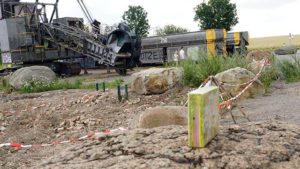
The old lignite excavator is a wonderful playground for the rough years of puberty. The tags are typical and often rough. When we realised the placement with Mr Albrecht, two boys and a girl were playing hide and seek there. Now and then other visitors came, mostly adults, but also children. The pubescents then decided according to the situation whether the visitors should have any influence on their behaviour.
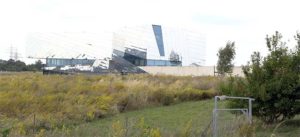
Experience the oldest hunting weapons at the original place of discovery
The Schöningen Research Museum uniquely combines the exciting experience of the Palaeolithic Age with cutting-edge archaeological research in an innovative exhibition concept. Visitors travel back about 300,000 years to the Palaeolithic Age and meet the first inhabitants of Lower Saxony. In exciting presentations, they experience what a hunting expedition might have been like some 300,000 years ago. They can marvel at the Schöningen spears in the immediate vicinity of the place where they were found, where they were left about 300,000 years ago and found in 1994 – and where excavations are still taking place today.
The Schöningen spears are among the most important archaeological finds worldwide. They are the oldest completely preserved wooden weapons in human history and revolutionised our image of the first humans in Central Europe. For archaeology, they are like an open book, providing a glimpse back into the living world of the Palaeolithic Age. The spears prove it: Homo heidelbergensis planned his actions, possessed technological skills, had sophisticated hunting strategies as well as communication skills and a complex social structure. The history of our ancestors from the Palaeolithic Age had to be rewritten.
Whether school classes, students, families, tourists or experts: the public can look forward to an eventful permanent exhibition, look over the shoulders of archaeologists at work in a glass laboratory and become researchers themselves in the interactive visitor laboratory. And the living environment of the Palaeolithic Age is brought to life not only in the exhibition, but also on the outdoor grounds. The extensive park with wild horses and an adventure trail invites visitors to relax. The visit is rounded off by the aesthetic fusion of world-class modern architecture and a landscape designed in the style of the Palaeolithic Age.
The geological peculiarity of the Schöningen site also provides a revealing insight into the climatic history of the region. The layers of earth provide unique insights into the development of the climate between two ice ages. Environmental changes and man’s adaptation to them are therefore further thematic complexes in the permanent exhibition. This creates a link to the phenomena and mechanisms of current climate change.
As a recognised extracurricular place of learning, the Schöningen Research Museum also offers an extensive, pedagogically prepared programme for teachers and school classes, especially with regard to the concept of Education for Sustainable Development (ESD).
Since 1 July 2019, the Lower Saxony State Office for the Preservation of Monuments (NLD) has reorganised and restructured the teaching of the archaeology of hunter-gatherer groups of early humans at the Schöningen site as a research museum. In research museums – such as the museums of the Leibniz Association – research, collection and mediation are thought to be inseparable. The Schöningen Research Museum is the first to anchor the unique site of research in the open-cast lignite mine in Schöningen in this unit in the region and in the system of cultural institutions in south-eastern Lower Saxony in the long term, and it cooperates closely with the research partners.
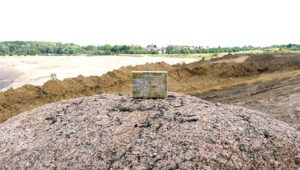
The first meaning of the word “Findling” is erratic block or glacial erratic
An erratic boulder is a very large stone, usually lying singly, that was transported by glaciers during the ice ages and deposited in its present location. When the ice melts and the glacier retreats, they remain as erratic blocks. Erratic boulders are the most common form of erratic blocks. The boundary between boulders and the smaller boulders is drawn at a volume of one cubic metre.
Distribution
Erratic blocks are a typical geological and geomorphological feature of landscapes that have been formed by glaciers. In Europe, these are especially the Scandinavian peninsula (including northern Central and Western Europe) and the glaciation area around the Alps.
Origin of the erratic blocks
A glacier as a solid body does not sort the material (moraine) transported by it. This applies to the uptake of the rock (by erosion or falling onto the glacier), transport and deposition (sedimentation). The erosion of large rock fragments occurs either by picking up already loosened rocks when the glacier passes over them, or by freezing and breaking out blocks at the bottom of the glacier. The latter happens mainly on the lee slopes of round crags. When mountains tower above the glaciers, as in the Alps, rocks can also fall onto the glaciers from above; such boulders generally show sharper, rather than more rounded, fracture edges. As a solid body, it is readily possible for the glacier to move material ranging from the minimum grain size of clay minerals to chunks of over ten thousand tonnes in mass.
Deposits deposited directly from the ice are unsorted and usually also unstratified. In German-speaking countries, the term “Geschiebemergel” (boulder clay) has become established. Although boulder clay contains considerably more fine material (clay, silt, sand and gravel), larger and larger stones are still found.
In the Scandinavian glaciation area, erratic boulders are mostly found within ground moraine landscapes, which belong to the Glacial Series. However, they can also occur in other elements of the Glacial Series, for example as erosion residues in meltwater sands.
In northern Central Europe, large erratic boulders are usually igneous rocks, such as granite, or metamorphic rocks. Sedimentary rocks are much rarer due to their lower resistance. In the Alpine region, there are more sedimentary rocks based on limestone, such as the Dengelstein, but also very large granitic boulders, such as the Pierre des Marmettes.
Erratic blocks as a problem of science
In the scientific world view of the 18th century, which regarded the history of the earth since creation as largely static, rocks in areas from which they obviously could not have originated geologically were a problem. From the middle of the 18th century onwards, geologists were intensively concerned with the question of what forces could have transported the erratic blocks over such long distances, for example from Scandinavia to the North German Plain and from the Alps to the Alpine foothills. Legendary explanations, such as giants hurling the stones through the air, were no longer accepted in the Age of Enlightenment. Instead, volcanic processes were considered, and the dead ice holes were interpreted as volcanic craters. In 1787, the Swiss politician and local historian Bernhard Friedrich Kuhn (1762-1825) had already suspected glacial activity as the cause, and the Scottish geologist James Hutton (1726-1797) had also expressed the same opinion, but the idea of a glaciation of large parts of Europe contradicted the world view of the time. Hence the term Erratic Block was coined, as the stone block had apparently strayed (Latin errare “to wander about, roam”).
The term Ice Age had not yet been coined. Rather, it was imagined that the huge boulders had been carried from the north on ice floes during the Flood or other flood catastrophes to where they were found today in northern Germany. This is still true today for the so-called drift blocks. The erratic blocks in the Alpine foothills could also have been carried by large masses of water from the Alpine peaks far into the foothills, it was assumed. Goethe, who was himself a geologist at the time, described the problems with the erratic blocks in mocking verse in his drama Faust II.
The thesis that glaciers had once covered large parts of the Alps and parts of northern Europe was put forward in 1822 by Ignaz Venetz (1788-1859). He was only listened to by Jean de Charpentier (1786-1855), the salt works director in Bex (Canton Vaud) in the Swiss valley of the Rhone.
From 1835 onwards, the German naturalist, geologist and botanist Karl Friedrich Schimper (1803-1867) travelled through Germany and Switzerland with lectures on the problem of the erratics and his ideas about a “world winter” and coined the term ice age. Together with Charpentier and the Swiss naturalist Louis Agassiz (1807-1873), the theory was further developed and substantiated by research on recent glacial landscapes. The problem of transporting the boulders through the ice of the slow-flowing glaciers could be considered solved. However, it took until the 1870s for the theory of ice ages to gain acceptance. The contribution of Schimper, who had not written any books but had only given oral reports or short letters, was almost forgotten in the process.
Cultural history
In the Neolithic period, erratic blocks were used to build megalithic tombs in northern, central and western Europe. The Central European variant of the Pan-European megalithic sites is primarily found in northern Germany (Westphalia, Lower Saxony, Schleswig-Holstein, Mecklenburg-Western Pomerania, Saxony-Anhalt), but also in Hesse (Wartberg Culture), the Netherlands, Poland, Denmark and southern Scandinavia. The unhewn, sometimes huge stone blocks bear (sometimes strange) proper names that are usually associated with legends and sagas. Besides buildings, monuments were also built from unhewn (Ulan monument) and hewn erratic blocks (Lindhoop monument in Kirchlinteln). Worked erratic blocks were used as anvil stones, dengel stones, meadow or road rollers. A roller with a diameter of 1.2 m and a width of one metre and weighing three tonnes lies on the Möhr farm in Schneverdingen. Erratic blocks are/were also used as gravestones (e.g. Hermann Löns grave). Small rolling stones (from boulders) were used in rural well construction or split for foundations or water channels.
In 1934/36 Heinrich Himmler had 4,500 boulders collected near Verden (Aller) for a memorial to the Saxons killed by Charlemagne at the Blood Court of Verden, the so-called Saxon Grove. Valuable graves must have been destroyed in the process.
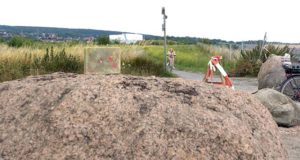
The second meaning of the word “Findling” is foundling.
Foundling (neuter; sometimes also lost child or foundling, Middle High German vundelinc for “abandoned, found child”) is a term for a found usually nameless child who was previously actively abandoned or given away by the unknown parents (usually the mother) often shortly after birth. These infant children were often left behind in the hope that someone would find and take them in. Since the Age of Enlightenment, children who are abandoned by their parents in an institution (foundling home) have also been referred to as foundlings.
Reasons that can lead to the abandonment or relinquishment of children include economic hardship of the parents, deformities, and physical infirmities of the child, as well as cultural aspects such as illegitimacy, sacrifice or offering to gods.
History
Antiquity
The abandonment of children after birth is reflected in many epochs and cultures of mankind. In addition to mythological traditions, a reference to the subject can already be found in the Old Testament in the book of Ezekiel (Ez. 16,4,5).
“No eye rested mercifully on you to do any of these things and to show compassion; you were rather thrown out into the open field on the day of your birth, because they detested you. […]”
Ancient
Plato in his Politeia and Aristotle in his writing Politiká argued that children with disabilities and children of the lowest classes should at least be removed from sight in order to meet some form of “selection”. In addition, Plato held that a couple should not bring more children into the world than they could afford. In Sparta, it was the custom and law to have children examined by the elders of the community and to abandon those born with “defects” in a crevice at the foot of Mount Taygetos near present-day Sparta or to plunge them in. If the elders agreed, the child remained alive. In Athens, the Solonian constitution stipulated that it was the father’s sole responsibility whether he would raise or kill his children. This decision was made, among other things, at the Amphidromia festival. If the newborn was carried around the hearth by the father, it remained in the family and was given a name. A right of the father to abandonment is not known. The abandonment or killing of children was closely linked in everyday life. Both were frequent motifs in Greek poetry of the 5th century BC, to which entire tragedies such as Ion by Euripides were dedicated. In an exceptional case in Gortyn on Crete, it is documented that the mother was granted the right to abandon the child upon divorce. In general, it can be said that in Ancient Greece, male offspring were considered far more important than female offspring.
Child abandonment was also a means of family planning in the Roman royal period. Cicero, Livius or Seneca tolerated child abandonment as something common. In ancient Rome, it was the custom to lay the child on the ground immediately after its birth. If the father picked it up, he accepted it as his own. If he did not, the child was abandoned and anyone could take it. Unwanted babies were abandoned immediately after birth on temple steps, crossroads or marketplaces, among other places. The hope of the parents was that the infant would be taken and raised by someone. Often, however, the infants were condemned to slavery or to later work in a brothel. It was not uncommon for prostitutes (hetaeras) to also raise foundlings in order to later have them work for them and thus have a secure livelihood in old age. Other reasons for abandoning babies included marital problems, economic and social hardship or giving birth out of wedlock. Primarily, girls were victims of child abandonment. Reasons for this were of an economic nature, such as maintenance until marriage and the subsequent dowry.
The legal status of foundlings, if they were not found dead and (as Galen reported) dissected for anatomical studies, was regulated in the Roman Empire by legal provisions such as the Sententiae Syriacae. It was up to the head of the household to decide whether a child was allowed to live or not. This was regulated by the patria potestas (paternal authority) in Roman law. This legal position also applied to all other members of the household (wife, children, slaves and other adult relatives). The father of the household thus also had the right, among other things, to kill, abandon or sell the offspring of his adult son. From 529 BC foundlings were given the status of freeborn and from 374 BC abandonment became a capital offence.
Tertullian and Lactance were critical of abandonment. In 380 AD, Christianity became the state religion in Rome and its provinces. It fought against abandonment. The child was no longer subject only to the father of the house, but also to the “divine father”. It was a creature of God. Moreover, it was considered a commandment of love of God and neighbour to protect a defenceless life.
At the Synod of Vaison (442 AD), citing an edict of the emperors Flavius Honorius and Theodosius II, it was decided that the finding of children should be publicly proclaimed in the church. If the child was not reclaimed within the following ten days, the finder was to raise it for a fee and consider it his property. The new parents were supervised by the church. Foundlings were henceforth under his and the Praeses’ or bishops’ protection by the more extensive legislation of Emperor Justinian, the Codex Iustinianus. Abandonment was eventually prohibited and punishable by blindness or execution.
Middle Ages
The introduction and spread of Christianity in Europe over many centuries nevertheless did not lead to any uniform development in the foundling system and in dealing with abandoned children. Abandonment continued to be a common means of getting rid of unwanted offspring. In the early Middle Ages, marble basins were attached to churches in the larger cities of the Frankish Empire (Arles, Mâcon or Trier). Here the unwanted children could be deposited. Saint Goar also described this practice in his biography De vita et miraculis sancti Goaris. The respective sextons of the church or needy people of the parish, so-called matriculants, took in the child and looked for an acceptance for the abandoned child. If the child was adopted by foster parents, this had to be confirmed by the church, usually by the bishop. Through this confirmation, the child became the property of the new parents and was also under the protection of the church. In Italy, the sale of children abandoned in churches by the finder was not uncommon in the 6th century. Some children who could not be placed were taken in and brought up in the newly founded monasteries. Sometimes children whom their parents were unwilling or unable to care for, such as Hildegard of Bingen, were given directly to a monastery by oblation. Ulrich von Zell noted in this regard:
“If these (parents) have their house full of children and one of them is lame or mutilated, hard of hearing or blind, humpy or lethargic or otherwise afflicted with an infirmity, so that it is less useful for the world, they sacrifice it to God with a great vow, so that it may become a monk, although they do not do it because of God, but merely for the sake of freeing themselves from the burden of education and nourishment, and so that the other children may be better provided for.”
The children affected were often illegitimate or deformed children as well as children from poorer social classes, among them predominantly girls. When foundlings were found, they often wore a small bag of salt around their necks as a sign that they had not yet been baptised. If it was not known whether the foundling had been baptised, the baptism was repeated conditionally. The priest spoke the formula: “If you have already been baptised, I will not baptise you”.
Despite threats of severe penalties, infant abandonment increased during the Middle Ages, especially in Italy, and became a major social problem. In France, it was the duty of the sovereign to look after abandoned children (épave onéreuse). They fulfilled this duty only to a very limited extent, if at all. Responsibility for this was often left to the local communities. In cities such as Marseille, Douai or Lyon, people who were sick, weak or destitute found shelter and care in the Maisons de Dieu (Houses of God).
The first institution for foundlings is said to have existed in Trier in the 6th century. The first foundling home was founded in 787 by Bishop Dateus in Milan. The children were cared for by wet nurses for 15-18 months and could remain in the institution until the age of seven. After that, they were supposed to learn a trade. Some were hired out as servants. Girls were married off when they were about 12 years old. Foundling homes subsequently became widespread in Europe, first in the Romanic countries.
Before the introduction of Christianity, in Iceland and Norway the fathers or, in the case of children born out of wedlock, the mother’s brother, had the right to abandon the newborn child. In Iceland, the introduction of the Christian religion by the Althing in the year 1000 was linked to the condition of being allowed to continue to abandon children. The ban on child abandonment was only gradually established in Norway. Under King Olav, abandonment was still punishable by a fine in the Gulathingslov. From the reign of King Magnus onwards, if the child died in abandonment, the father lost property as well as peace and the act was outlawed as Great Murder.
In the High Middle Ages, the abandonment of children in Europe declined. The increase in prosperity during this period may also have played a part in this. There were fewer famines and wars. More towns were founded and trade and crafts with their guilds flourished. This gave the descendants of the lower classes greater opportunities for development, including being employed as craftsmen or domestic servants. A life as a monk seemed attractive to many parents for their offspring. However, due to the large number of children given up, the monasteries were overburdened at this time. Pope Gregory IX issued a decree that girls could not be admitted to a monastic order before the age of 12 and boys before the age of 14. Innocent IV confirmed the decree and additionally demanded a renewal of the religious vows at the age of 15. One response to this situation was the founding of Foundling Institutes in other cities of the late Middle Ages.
At the end of the 12th century, Guy de Montpellier founded the Order of Hospitallers of the Holy Spirit (Ordre du Saint-Esprit) in France. His hospital in Montpellier served to receive abandoned children, the poor and the sick. The hospital fraternity received papal approval from Pope Innocent III in 1198. In the same year, he entrusted Guy de Montpellier with the foundation, management and further development of a hospital in Rome and decreed the installation of revolving shutters (torna ruota) at the gate there. These baby hatches made it possible to deposit foundlings anonymously. The parents could inform the nursing staff about the abandonment by means of a bell. Through the turnstile, abandonment was in a certain way legitimised again. The church tried to influence this through Christian morality. Illegitimate mothers who were accused of abandoning or even killing their children hid the “shame” of their motherhood in this way. The children, in turn, were saved from starvation, death from cold or infanticide. Often the children were raised behind closed doors and thus disappeared from society’s view. The prevalence of the surname Esposito (Italian for abandoned) in southern Italy still testifies to the high proportion of such children in the population. In the years that followed, many foundling homes, such as the Santo Spirito in Sassia, were founded in Italy and Spain, modelled on the Order of the Holy Spirit.
In the Holy Roman Empire, concubinage was widespread alongside existing marriage until the High Middle Ages. Illegitimate children were initially placed on an equal footing with legitimate children. Only they could not inherit the status of the father. With the strict introduction of monogamy through ecclesiastical influence, the position of illegitimate children deteriorated in the early late Middle Ages. It was often unmarried maids who abandoned their newborns. The fathers of their children were often their employers, who took advantage of the maids’ (in Mediterranean countries, the house slaves’) dependence. Children born out of wedlock were restricted in their entire legal status, secular and ecclesiastical. Until the 13th century it was common for hospitals, such as the Katharinenhospital in Esslingen, to take in foundlings. There was no spatial separation of foundlings from other inmates. It was not until the 14th century that foundling homes were founded in German cities (1337 in Ulm, 1341 in Cologne, 1359 in Nuremberg, 1376 in Freiburg, 1395 in Strasbourg, 1395 in Augsburg). One reason for this may be the spread of the plague and the accompanying economic hardship and health situation of the people, especially of the lower classes. However, these establishments did not have any fillets and were mostly the result of donations from wealthy citizens. In the city of Strasbourg at this time, about 6-20 children were abandoned per year. The penalties for abandoning children were, for example, drowning in the cities of Strasbourg and Basel, banishment in Nuremberg or a fine in Lucerne.
In the other countries of Europe, too, the number of foundling homes in the cities increased by leaps and bounds, e.g. in Venice (1383) or Paris (1362). An example of an orphanage that took in orphans and foundlings is the Ospedale degli esposti for boys, founded in Venice in 1340 by the Franciscan Pietro d’Assisi. This was followed in 1346 by the Ospedale della Pietà for girls, founded on the initiative of female members of the Venetian patriciate. The children were trained there in various professions, the boys mainly as craftsmen for the arsenal or as sailors, the girls as silk washerwomen or musicians, who could save up a dowry through their work.
Modern times until the 17th century
No specialised homes for foundlings existed in Switzerland before the 16th century. The abandonment or relinquishment of children does not seem to have been a widespread problem. Reasons for this could have included the rigorous persecution of child abandonment, the low proportion of illegitimate children or the few towns in this period. In a later analysis of texts from the 14th to 15th centuries, 11 cases of child abandonment were found in the Western Alps, all from the diocese of Aosta. In the city of Geneva, abandoned children were taken in by the Boîte de Toutes-Ames, a municipal charity. In 1523, about 40 children, including three foundlings, were in their care. After the Reformation, children who had been separated from their families were often placed in the Hôpital général. About ten children per year were cared for, the majority of them orphans and illegitimate children. In the city of Bern, from 1685 onwards, the Ammkinder Rodel registered all the children who were placed in foster care by the city. Some of them were foundlings. In Lucerne, 12 foundlings were documented throughout the 18th century. Exceptions were Ticino and Geneva. Here the circumstances were similar to those in Italy and France. The illegitimate children from Ticino were brought to the hospitals of Como, Milan or Novara. In Geneva, the Hôpital général took in 690 children between 1745-1785, including 458 foundlings, half of whom were less than a week old.
From 1700 onwards, many poorhouses and orphanages were established throughout Europe, where orphans and foundlings were taken in and found support. In some cases, wealthy merchants and merchant lords also took care of the children by maintaining charitable foundations.
18th-21st century
During the French rule, the number of foundlings in Geneva rose sharply. From 1799 to 1813, 559 children were registered. From 1814 to 1823, there were only 96 children, and later they remained at an even lower level of between 25 and 19 children.
Sections 345-388 of the Code civil regulate the legal status of minors and questions of adoption of foundlings or foster children. Subsequently, legislation in some European countries took its cue from Napoleon’s formulations.
The option of anonymous birth and child relinquishment was first offered in 1999 by the Donum Vitae pregnancy counselling service in Amberg, Bavaria. Since 2000, there have been modern baby drops in Germany. While anonymous birth is only tolerated, confidential birth has been regulated by law in Germany since 1 May 2014. Article 7 of the Act on the Expansion of Assistance for Pregnant Women and the Regulation of Confidential Birth of 28 August 2013 amended the Pregnancy Conflict Act accordingly.
Legal assessment
The anonymous relinquishment of newborns or their abandoned finding touches on numerous legal issues from criminal law (violation of the duty of care or upbringing, abandonment, bodily injury and homicide offences), personal status, nationality, parentage and custody law as well as constitutional law.
Germany
A 1938 draft law on the revocation of naturalisations and the deprivation of German citizenship provided that foundlings should be expressly considered stateless “until an examination of their racial classification is possible”. The beginning of the Second World War prevented the implementation of the draft. Today, the acquisition of German citizenship for a foundling is regulated by legal automatism. A foundling who is found in Germany is considered to be the child of a German until proven otherwise (§ 4 para. 2 (StAG)).
Foundlings must be reported by the finder to the municipal authority (usually via the youth welfare office) no later than the following day (§ 24 Personenstandsgesetz (PStG)). There, the entry in the civil register, the determination of the date of birth and the name is ordered.
From a legal point of view, a foundling is a child whose marital status cannot be determined and who therefore needs a guardian (§ 1773, paragraph 2 of the German Civil Code (BGB)). Guardianship is governed by §§ 1773 ff BGB, similar to the provisions for orphans. The guardian, in practice usually the youth welfare office as official guardian (§ 1791b BGB), has the right to give the child a name and, among other things, the duty to find the parents.
If the search is unsuccessful, the child is usually quickly adopted. Even if parents are found, adoption is possible even against the will of the parents because of the abandonment of the child (see § 221 Criminal Code (StGB) as well as violation of the duty of upbringing and care according to § 171 StGB) (substitution of parental consent by the family court according to § 1748 BGB).
Switzerland
According to Article 3 of the Swiss Citizenship Act (BüG), a child found in Switzerland with unknown parentage (foundling) is also granted Swiss citizenship. However, this is lost again if a nationality is established by descent while the child is underage and the child does not become stateless as a result.
Netherlands
By legal automatism, a foundling is a Dutch citizen if it is found on the territory of the Kingdom or on a sea-going vessel or in an aircraft registered in the territory of the Kingdom. An exception to this is the place of birth principle, if it is established within five years of the finding that the child has a different nationality by birth.
Great Britain
Foundlings found in Great Britain have been considered British by birth since 1964.
Morocco
In Morocco, foundlings are automatically granted Moroccan nationality under the 1958 Nationality Act, provided they have been in foster care with Moroccans for five years under a kafala ‘adoption’.
United Arab Emirates
The 1972 Citizenship Law stipulates that foundlings of unknown origin are presumed to be UAE nationals from birth.
Japan
In Japan, the Nationality Law of 1950 stipulates that any foundling, as long as the parents are unknown, acquires Japanese nationality by birth.
Health consequences
The morbidity and mortality rate among foundlings was particularly high. In 1798, Christoph Wilhelm Hufeland reported that out of 7,000 foundlings in Paris, only 180 survived after 10 years, despite adequate care and nutrition.
In Spain, the individual cities include:
Zaragoza, from 1786-1790 2446 foundlings taken in – 2246 died,
Calahorra, Logroño and Vitoria, 1794 and 1797 610 foundlings taken in – 400 died,
Huesca, 1798 164 foundlings admitted – 115 died.
Within a year, in the hospice of Santo Spirito in Sassia, of the 2646 boys admitted, 1300 died and of the 2890 girls admitted, 1334 died.
In Italy, in the 2nd half of the 18th century, it was up to 80 per cent. At the beginning of the 19th century it was about 50 percent in the Moscow Foundling Hospital and about 75 percent in the St. Petersburg Foundling Hospital. The majority of children in this period died in their first year of life. In the Madrid Foundling Hospital, the rate was also around 80 percent in the same period, and in France it was around 75 percent nationwide. As late as the middle of the 19th century, about 70 percent of all children died in the Vienna Foundling Hospital.
Marasmus is sometimes also referred to as mental hospitalism, the “withering away and eventual extinction” (René A. Spitz 1978) of children born healthy in themselves as a result of total emotional deprivation. Spitz called this state “anaclitic depression”. This is also referred to as decomposition.
Reception in art
Film
The film The Kid is a 1921 US silent tragicomedy directed by Charlie Chaplin. A number of film historians see in the film a reference to Chaplin’s own childhood as a half-orphan and his life in the slums of London with a mentally ill mother. Edna Purviance played the role of the mother who abandoned her newborn child to pursue a career at the opera. Jackie Coogan played the role of the growing foundling. Mother and child, after failures of searching and years of separation, reunite at the end of the film. In 2011, the film was listed in the National Film Registry as “culturally, historically and aesthetically significant”.
Further attention was given to the theme in films including Das Findelkind or Hajo Gies’ 2009 German television film Die göttliche Sophie – Das Findelkind.
The animated film by Isao Takahata The Legend of Princess Kaguya (2013) is based on the fairy tale Taketori Monogatari, written around 900. This fairy tale is also Japan’s oldest written story. A poor bamboo collector finds a tiny baby in the forest. Amazingly quickly, it grows into a young, strikingly beautiful woman. When the bamboo collector later also finds a treasure, he is sure that he must prepare a life as a princess for his adopted daughter. Against her will, they move to the city. The wild foundling becomes the sad Princess Kaguya. In 2015, the film was nominated for the Oscar 2015 in the category Best Animated Feature Film.
A thematic echo can also be found in the 2008 animated film Kung Fu Panda directed by Mark Osborne and John Stevenson.
In the 2016 film drama by Derek Cianfrance The Light Between Oceans, the theme, set on the Australian island of Janus Rock shortly after the end of the First World War, is artistically processed. It is about a wrongly adopted foundling and the question of what constitutes true motherhood and weighs more in the end – blood ties or life spent together.
In the US space western series The Mandalorian, also Star Wars, by writer and producer Jon Favreau, the fictional character Baby-Yoda represents a foundling child that Mandalorian protagonist Din Djarin must care for. This child has “magical powers”.
Cover of the British edition from 1926 with illustrations by Percy Tarrant (1881-1930)
Literature
The novel Tom Jones: The Story of a Foundling by Henry Fielding is considered a classic of world literature. It is about the foundling and ward of Squire Allworthy, a wealthy and benevolent landowner in Somerset. The novel is about love, class, escape, remorse, magnanimity, forgiveness and much more, before the protagonist is able to marry his childhood sweetheart Sophia Western, daughter of a neighbouring landowner, who reciprocates his passion.
Wuthering Heights is another classic of 19th century British fiction and the only novel by Emily Brontë (1818-1848). In this one, the foundling Heathcliff embodies the protagonist of the plot.
In the classic novel The Hunchback of Notre-Dame by the French writer Victor Hugo, the plot centres on the beautiful Esmeralda and the foundling Quasimodo.
Music
In 1749, the famous anthem Blessed are they that consider the Poor and Needy, penned by George Frideric Handel, was first performed at the Foundling Hospital in London in the presence of the Prince of Wales Frederick Louis of Hanover. From 1750 onwards, Handel performed the Messiah once a year in the hospital’s newly built chapel as a benefit concert. In his will, he also bequeathed the handwritten score of the work to this institution.
Representation in mythology
Suspension myths can be found among a whole range of peoples of the earth, similar in certain aspects. Sometimes the depictions follow a certain pattern. For example, the abandoned child often ends up as a hero or founder of a settlement, an empire or a religion. The abandoned children are often children of gods or their descendants, who may later even become part of a myth themselves. The places of abandonment are often sacred mountains, rivers or springs. The children usually grow up far away and without knowledge of their true identity. In the course of time, they often acquire great knowledge, and the fulfilment of prophecies often goes hand in hand with this.
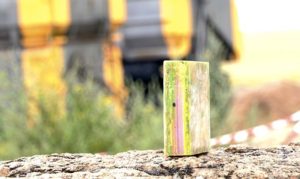 Yellow is the colour between orange and green on the spectrum of visible light. It is evoked by light with a dominant wavelength of roughly 575–585 nm. It is a primary colour in subtractive colour systems, used in painting or colour printing. In the RGB colour model, used to create colours on television and computer screens, yellow is a secondary color made by combining red and green at equal intensity. Carotenoids give the characteristic yellow colour to autumn leaves, corn, canaries, daffodils, and lemons, as well as egg yolks, buttercups, and bananas. They absorb light energy and protect plants from photo damage in some cases. Sunlight has a slight yellowish hue when the Sun is near the horizon, due to atmospheric scattering of shorter wavelengths (green, blue, and violet).
Yellow is the colour between orange and green on the spectrum of visible light. It is evoked by light with a dominant wavelength of roughly 575–585 nm. It is a primary colour in subtractive colour systems, used in painting or colour printing. In the RGB colour model, used to create colours on television and computer screens, yellow is a secondary color made by combining red and green at equal intensity. Carotenoids give the characteristic yellow colour to autumn leaves, corn, canaries, daffodils, and lemons, as well as egg yolks, buttercups, and bananas. They absorb light energy and protect plants from photo damage in some cases. Sunlight has a slight yellowish hue when the Sun is near the horizon, due to atmospheric scattering of shorter wavelengths (green, blue, and violet).
Because it was widely available, yellow ochre pigment was one of the first colours used in art; the Lascaux cave in France has a painting of a yellow horse 17,000 years old. Ochre and orpiment pigments were used to represent gold and skin colour in Egyptian tombs, then in the murals in Roman villas. In the early Christian church, yellow was the colour associated with the Pope and the golden keys of the Kingdom, but it was also associated with Judas Iscariot and used to mark heretics. In the 20th century, Jews in Nazi-occupied Europe were forced to wear a yellow star. In China, bright yellow was the colour of the Middle Kingdom, and could be worn only by the emperor and his household; special guests were welcomed on a yellow carpet.
According to surveys in Europe, Canada, the United States and elsewhere, yellow is the color people most often associate with amusement, gentleness, humor, happiness, and spontaneity, but also with duplicity, envy, jealousy, avarice, and, in the U.S., cowardice. In Iran it has connotations of pallor/sickness, but also wisdom and connection. In China and many Asian countries, it is seen as the color of happiness, glory, harmony and wisdom.
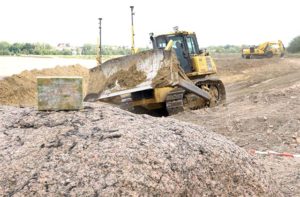
Renaturation is the restoration of near-natural habitats from cultivated, used ground surfaces. Both nature and humans benefit from the renaturation of water systems, in which reintroduced species such as the beaver actively participate.
For local residents, rivers and streams that have been restored to their natural state pose less risk of flooding. In addition, the quality of life increases wherever the most diverse possible habitat for animals and plants is created, which also plays an important role in the decomposition of pollutants such as wastewater or fertiliser.
Renaturation as a scientific sub-discipline of biology
The theory and practice of habitat restoration with defined requirements is the subject of the scientific sub-discipline of renaturation ecology and is counted among the environmental sciences. The subject of the measures can be, among other things, agricultural land, melioration areas, abandoned industrial and transport facilities or post-mining landscapes. The goal is an ecosystem that regenerates and sustains itself in the long term largely without human help.
In the university sector, the following courses of study, chairs and specialist groups (in the German-speaking area) now focus on renaturation:
Aquatic Ecology, at the Faculty of Biology of the University of Duisburg-Essen.
Research areas of the Chair of Renaturation Ecology at the Technical University of Munich
Aquatic Ecology and Nature Conservation at the Carl von Ossietzky University Oldenburg
Ecosystem Research: Renaturation of Riverine Floodplains, at the University of Koblenz-Landau
In Switzerland, the renaturation of rivers and streams is also called revitalisation.
Significance for humans and nature
Historical
The water sprouting policy
Over the past 100 years, numerous rivers and streams have been straightened, moors and wetlands drained, soils further compacted by agricultural use. This policy of so-called water expulsion, which also involves pushing back floodplains with dikes, is increasingly showing its negative consequences. Where it is no longer possible to store water in the area, not only is less groundwater formed, but effective protection against flooding – especially during extreme weather events – is also no longer given.
The beginning of a rethink
In Germany, the first renaturation measures began to be implemented in the 1970s. The primary goal was to preserve the ecological diversity in floodplain landscapes and watercourses and to restore their functions to a natural balance. Unfortunately, the success of the respective projects was rarely adequately documented in the early days and had the reputation of being too expensive. In the course of time, renaturation projects increasingly focused on letting nature take its course in certain protected zones so that a certain momentum can develop. This not only proved to be financially more favourable, but the positive effects were also clearly demonstrable.
Since – not only in Germany – almost all water bodies are considered “severely impaired” from both a structural and an ecological point of view, the European Water Framework Directive adopted in 2000 calls for extensive renaturation measures. In addition to safeguarding water quality, the improvement of the overall ecological status, as well as the preservation of biodiversity and aspects of climate protection are gaining in relevance. In this context, renaturation and the preservation of peatlands are also defined for the first time as an important aspect of nature conservation and environmental protection.
Where the reintroduction of certain animal species, such as the beaver, is successful, it makes such an important contribution to the restoration of intact ecosystems through its contribution to landscape design that it is now considered a “flagship species” for water protection projects. Through its building activity, the beaver dams up watercourses, which makes it possible for numerous other species to settle and thus contributes significantly to the upgrading of watercourses and the renaturation of moors. In Bavaria, beavers were successfully reintroduced into the wild (from 1969) after having been extinct there for 100 years.
Another approach involves rewilding, the renaturalisation of natural areas by means of reintroducing the megafauna formerly present in the respective region. The reintroduction of large grazing animals, such as the bison, would favour, among other things, the conditions for the creation of wet meadows.
Current relevance of renaturation
On the occasion of the severe floods in Western and Central Europe that claimed more than 150 lives in Germany alone in July 2021, the German branch of Friends of the Earth Germany (BUND) is calling for a consistent expansion of ecological flood protection in order to prevent such dimensions in the future. Flood plains must be consistently designated for this purpose and must not be built on, used for agriculture or sealed by road construction.
Due to climate change in particular, humans have played a significant role in the frequency and severity with which floods and inundations occur. As a result of global warming, flooding became more frequent from the year 2000 onwards, as can be clearly seen from the list of flood events.
It has since been recognised that the loss of original floodplains means that the extent of flooding, especially during prolonged heavy rainfall, is more severe than before most rivers were built up and straightened. Numerous projects have therefore been started all over the world to renaturalise watercourses, restore riparian vegetation and return watercourses to a more natural state. The dismantling of dikes also plays a decisive role in this context.
Renaturation in different areas
The reforestation of natural forests and managed forests.
Water bodies and wetlands
Watercourse restoration
Watercourses
Whether natural or renaturalised, flowing waters are ecosystems that are home to numerous animal and plant species. Moreover, rivers attenuate flood waves wherever they are given enough space to overflow their banks. Near-natural stretches of water in cities also contribute to improving the urban climate and the residential environment.
The renaturation of straightened and channelised river courses attempts to restore the characteristics of the river bed and banks as a habitat, e.g. to enable the reintroduction of original animal and plant species by creating different flow velocities in the river. In order not to have an increased flood risk with an overall lower flow velocity, the flow cross-section is usually enlarged. Usually, the slope of the embankments is adjusted or the river course is widened. (Examples in Germany: Emscher, Isar, Jagst, Menach, Schlatbach, Schwalm, Sieg, Tauber, Untere Havel, Weschnitz, Wuhle or Wupper and in Switzerland: Aare, Aire, Linth, Simmi or Zihl) Exemplary measures are the meandering of the riverbed, the creation of gravel banks, river divisions, islands and kingfisher walls.
A special form of renaturation in cities is the opening up of underground canalised watercourses (dole) to enhance the quality of life.
Concrete measures in the riverbank and floodplain area
Riverine floodplains, riparian forests, and similar wetlands are increasingly being perceived as important biotopes, the destruction of which, with the loss of floodplains, can also have severe consequences for humans in the event of flooding. In Germany, the condition of these water-related biotopes was already recorded in 2009 by the Federal Environment Ministry together with the Federal Agency for Nature Conservation. It was found that two thirds of the original floodplains of rivers can be flooded during flood events. In some areas of the Danube, Elbe, Rhine and Oder rivers, between 80 and 90 percent of the original areas were no longer accessible by floodwater during inundation. In Germany, renaturation measures were therefore initiated from 2015 as part of the Blue Ribbon Germany programme by the Federal Ministry for the Environment in cooperation with the Federal Ministry of Transport. Preventive flood protection in particular is to benefit from the following measures:
Deconstruction or slitting of dikes and dams
Relocation of dykes inland to regain natural retention areas
Degradation of rivers and creation of natural riverbanks, also in possibly obstructed oxbow lakes by removing bank protection structures
Leaving or introducing deadwood
Gradual reintroduction of typical animal and plant species.
Examples of river sections
Renaturation has already begun in the following river sections:
Lower Elbe
Upper Weser
Lower Havel
Aller
Standing waters and wetlands
Original wetland near Schwafheim, North Rhine-Westphalia
In standing waters, or stillwaters, there is no current, unlike in flowing waters. They include natural bodies of water such as lakes, ponds, pools and tarns. In addition, stillwaters include artificially created water bodies, such as old water bodies cut off by river straightening, i.e. river branches and meanders separated from the main river, as well as man-made ponds.
Wetlands are biotopes where surface or groundwater is immediately adjacent to or reaches the ground surface. They include all bogs and swamps as well as wet meadows and marshes. Human intervention, especially drainage, has severely depleted wetlands worldwide.
Wet meadows
Wet meadows have almost completely disappeared due to drainage and conversion to arable land or pasture. These are wood-free biotopes on moist to wet sites. Periodically flooded floodplain meadows not only provide a habitat for numerous birds and insects, but also make a preventive contribution to flood protection, as they store large amounts of water and thus relieve the flowing waters.
The following measures can be used to renaturalise wet meadows:
Rewetting
Creation of floodplain by removing or slashing dikes
Soil preparation with forestry mulchers
Landscape management by removing bushes (scrub clearance and slashing)
Replanting by sowing typical plants
Compensation payments to farmers who contribute to the conservation of wet meadows
Because of their ability to store large amounts of CO2, peatlands make an important contribution to climate protection. Unfortunately, humans recognised this function only very late and had either completely destroyed or at least severely damaged the majority of existing peatlands through peat cutting and drainage. Due to their acute endangerment, intact raised bogs in particular are now predominantly under nature conservation.
At the same time, 10 million cubic metres of peat are still cut every year in Germany alone (of which around 90 per cent is in Lower Saxony). Drainage as well as peat loss lead to the destruction of the peat mosses and ultimately the entire peatlands. Peatlands that are still close to their natural state are also damaged by excessive nutrient input from adjacent agricultural areas and the air, which leads to eutrophication.
As part of the renaturation of peatlands, rewetting is intended to help restore an intact water balance. The typical moorland flora and fauna can then reestablish themselves on the wetted sites and the function of the moors can be restored in the medium term through the reintroduction of peat-forming plants. The contribution to climate protection would be considerable; if, for example, all drained peatlands in Germany were renaturalised through rewetting, up to 35 million tonnes of CO2 could be stored annually, according to the Federal Agency for Nature Conservation.
Soils
Soil remediation through soil improvement measures
Soil remediation is concerned with either improving soil properties, cleaning or recultivating soils that have been contaminated by pollutants. After economic use (especially by open-cast mining), restoration of a certain soil quality is a legal requirement in many countries. Soils that have been damaged by drainage measures can be revitalised by rewetting (see above).
Soil compaction can greatly reduce both the water conductivity and the air conductivity of soils. The condition of these soils can be improved either by mechanical loosening or by root penetration with deep-rooted plants. The soil structure can also be improved by enrichment with humus and less intensive use or a break in use.
Another problem is the enrichment of soils with pollutants. If these cannot be completely removed, a significant reduction of the pollutant content in the soil is sought. The most common methods of pollutant reduction include chemical methods, such as the extraction of pollutants by solvents, and biological remediation measures, in which pollutants can be removed from petroleum refineries or solvents with the help of natural organisms, by means of bioremediation. There are also special adsorption techniques by which pollutants can be chemically altered and thus significantly reduced (e.g. by changing the pH value).
Soil remediation through vegetation
Restoring a vegetation cover that ideally has the characteristics typical of the landscape is another important task in soil remediation.
Unplanned planting
For the initial revegetation of a remediated soil, it is possible to give nature free rein on brownfield sites. So-called ruderal vegetation establishes itself through seed dispersal – without human intervention – as a dynamic process on open areas. Low demands on location and soil quality characterise plants that are still popularly referred to as “weeds”. These pioneer plants can spread relatively quickly and in great diversity. However, since undesirable neophytes often come to predominate on succession areas, measures may have to be taken against their invasive spread.
Example of planned planting
At the Hainberg in Lower Saxony, near a quarry site for quartz sand, a compensation area is to be created that must meet certain qualitative requirements, as the area borders on a landscape conservation area. In this case, it was decided to plant oaks and hornbeams in several steps, with the aim of creating a forest that is as close to nature as possible. In order to allow for the greatest possible biodiversity, the planting of a hedgerow landscape was also planned to mitigate the loss of habitat due to quartz sand quarrying for various bird species.
Soil remediation by site
Opencast mine
The environmental impact of opencast mining is umganous; as land consumption is particularly high in this sector of the economy, post-mining landscapes are created in numerous places as a result of the closure of operational areas. In Germany, companies are obliged to recultivate abandoned areas. In Lusatia, according to the Lausitzer und Mitteldeutsche Bergbau-Verwaltungsgesellschaft, the following recultivation measures are used:
Recultivation by planting selected pioneer plants (ruderal vegetation)
Reforestation of mining landscapes
Stabilisation and revegetation of slopes by planting vegetation on embankments
Creation of lakes by flooding opencast mining areas; Lusatian Lakeland
Sealed surfaces
In the meantime, it has been recognised that the high proportion of sealed soils that have become impermeable as a result of construction work has adverse effects not only in the event of flooding.
In Germany, for example, around 45 percent of settlement and traffic areas are either built on, concreted, asphalted, paved or otherwise sealed. Neither water permeability nor other important soil functions such as aeration and soil fertility are lost as a result.
In the centre of cities, soil sealing can reach even higher proportions and affect up to 100 per cent of the existing area. Intact soil surfaces contribute to cooling through evaporation and have the ability to absorb water. Sealed surfaces instead store the sun’s heat and release it into the environment, resulting in a significantly warmer urban climate.
As the occurrence of heat waves increases in times of global warming, experts advocate in particular preventing the additional densification of cities wherever possible or compensating for it through greening. Balanced urban development should also take greater account of the evaporative cooling of water bodies and the cooling effect of trees in the future.
Unsealed, vegetated soils can provide a cooler urban climate on hot days and absorb water during rainy periods. The best effects through combined greening and reduction of sealing are achieved when the soils and greening of the city are considered as a whole. In addition to the creation of inner-city green spaces, an overall positive effect can be achieved through the continuous greening of roofs, streets and open spaces.
Agricultural land
Agricultural land is often contaminated by many years of fertiliser use. The complete decomposition of these pollutants will not be possible in the foreseeable future, also due to the size of the affected areas. In heavily contaminated farmland, the less contaminated subsoil can be brought to the surface by deep ploughing. Other possibilities are the application of an additional top layer or a restriction of use.
Another problem of conventionally farmed land is soil compaction caused by driving heavy, agricultural vehicles (such as combine harvesters) over the fields. Excessive pressure causes damage or destruction of the pores in compacted soil, leading to problems with oxygen supply and reduced water permeability. In years with extreme weather, this increasingly leads to yield losses due to impaired plant growth on compacted soils. Where root formation suffers due to compacted soils, soil erosion can be the result – especially in the wake of heavy rainfall. Measures against (additional) soil compaction include:
Reduction of contact pressure by agricultural vehicles through appropriate tyres and raising of the contact area.
Maximum wheel load of 10 t for dry soil and 6 t for wet soil
Tillage only on dry soil
If possible, no driving on wet soil (due to reduced load-bearing capacity)
Reduce the number of passes (e.g. by reducing the tillage intensity)
Reduce the area driven over
The retention of crop residues counteracts erosion and silting.
Mineral fertiliser can be saved by leaving crop residues, which are converted into humus.
Preferably use organic fertiliser
The cultivation of catch crops (see also intercropping) improves the soil climate.
Select the crop rotation according to soil-improving aspects.
Depending on the soil type, the pH value can also be optimised by adding humus or liming.
Effects and limits of renaturation
Renaturation usually does not completely restore degraded or unnatural areas to their condition before the intervention. Among other things, the biodiversity on the renatured areas remains lower than before the disturbance, and the carbon cycle and nitrogen cycle also have lower values after renaturation than the original ecosystems. The restoration of areas damaged by human use is thus no substitute for the preventive protection of ecosystems.
After intensive management by humans, a so-called “anthropogenically overprinted peatland landscape” can no longer be restored in such a way that an original or comparable near-natural state is achieved. The peat layers of degraded peatlands alone would require thousands of years to regain their former characteristics. Nevertheless, it makes sense to restrict or at best completely stop the use of severely affected peatlands in order to reduce the amount of greenhouse gases released.
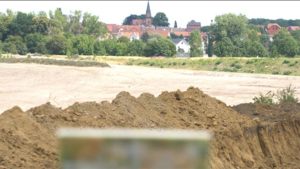
The third meaning of “findling” is the name for a grape variety.
Findling (grape variety) Foundlings in grape varieties are colloquially used to describe wild-growing and initially unknown varieties whose origin is unclear. However, the name is also used as a synonym of well-known grape varieties.
Franz Kimmig in Oberkirch in Baden-Württemberg selected a variety he had found in 1971. According to DNA analyses, it is Bouvier, which is still listed in the variety register of Germany under the name “Findling”. In the International Grape Variety Database (VIVC) and the German Grape Variety Database, it is not listed as a variety, but is a synonym of the Bouvier variety.
Another foundling is a mutation presumably from Müller-Thurgau. The differences are earlier ripening, lower yields and higher must weight. However, a DNA determination has not yet been carried out.
The variety Findling von Muhen with a dark red berry colour comes from Switzerland and is named after the municipality of Muhen in the district of Aarau in the canton of Aargau. It was found by a Swiss amateur traffic light photographer. The vine has an independent DNA profile that differs from Müller-Thurgau. However, the parentage (parentage) is unknown. The variety is listed in the International Vine Variety Database (VIVC) with VIVC No. 41572.
Click on the photos to see some co-creation details
With brick 1B1A we enter the second hexagonal protocol placement in Germany. It was at Castle Borbeck’s park in Essen.
It is considered one of the oldest landscaped parks in the Rhineland. In the 18th century, the last prince abbess of Essen, Maria Kunigunde of Saxony (1776-1803), had the garden redesigned in the “English-Chinese” style.
This included decorative elements such as a pavilion, a “Wirtshäusgen” and a “Bauernhäusgen” as well as an artificial ruin. In addition to this particular form of English landscape garden, the castle park also shows characteristics of a Baroque Garden to this day: the former cascade, lined by straight paths and leading axially towards the palace.
Whatever design elements may have been ‘in vogue’ at the time: Ever since the prince abbesses began to transform the former beech forest into a woodland park in the 16th century
the park has always represented the wealth and power of the authorities as well as the cultural concepts of landscape art in England in China.

